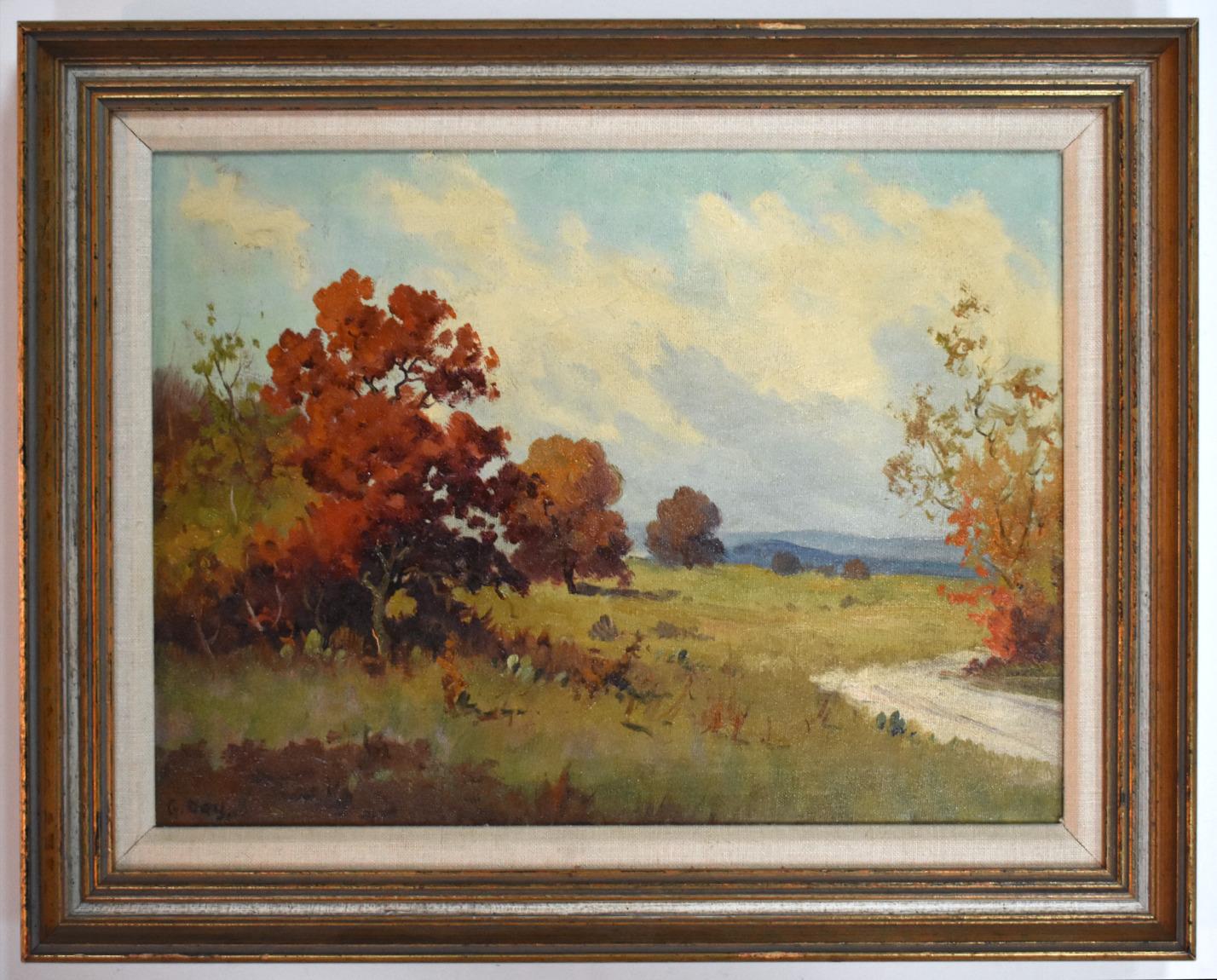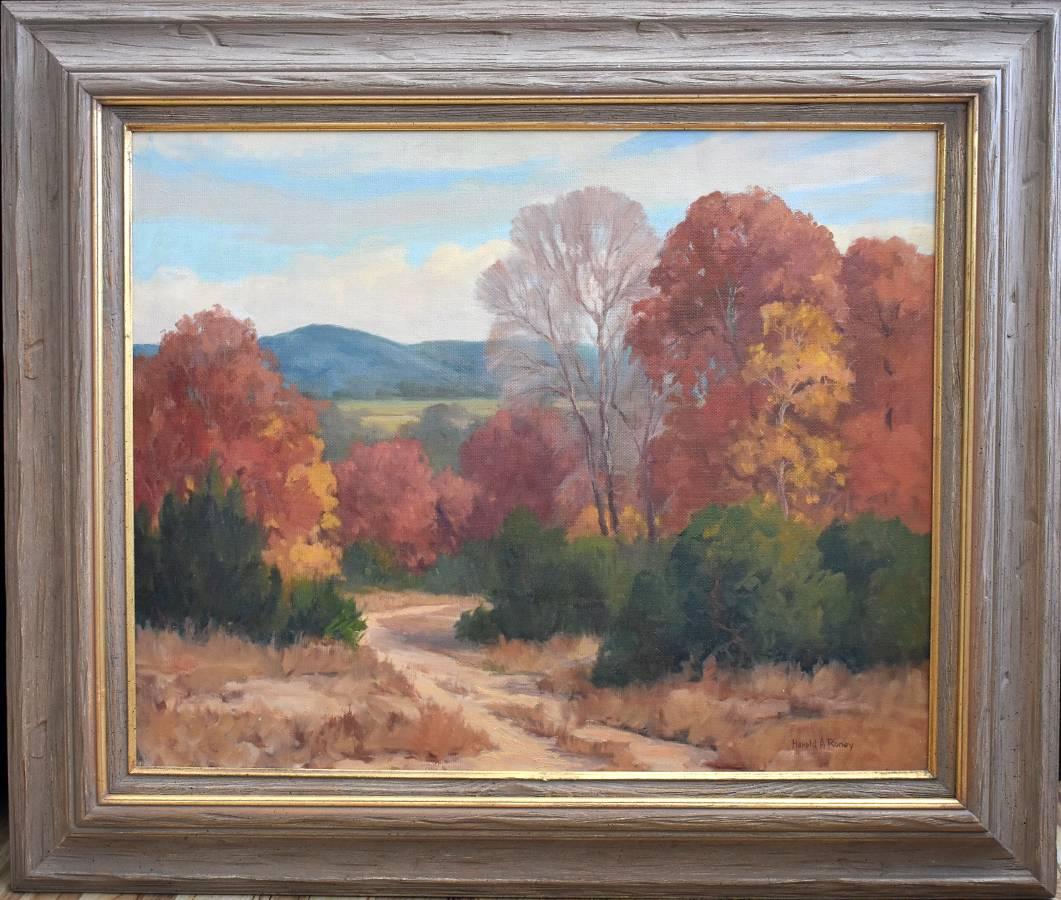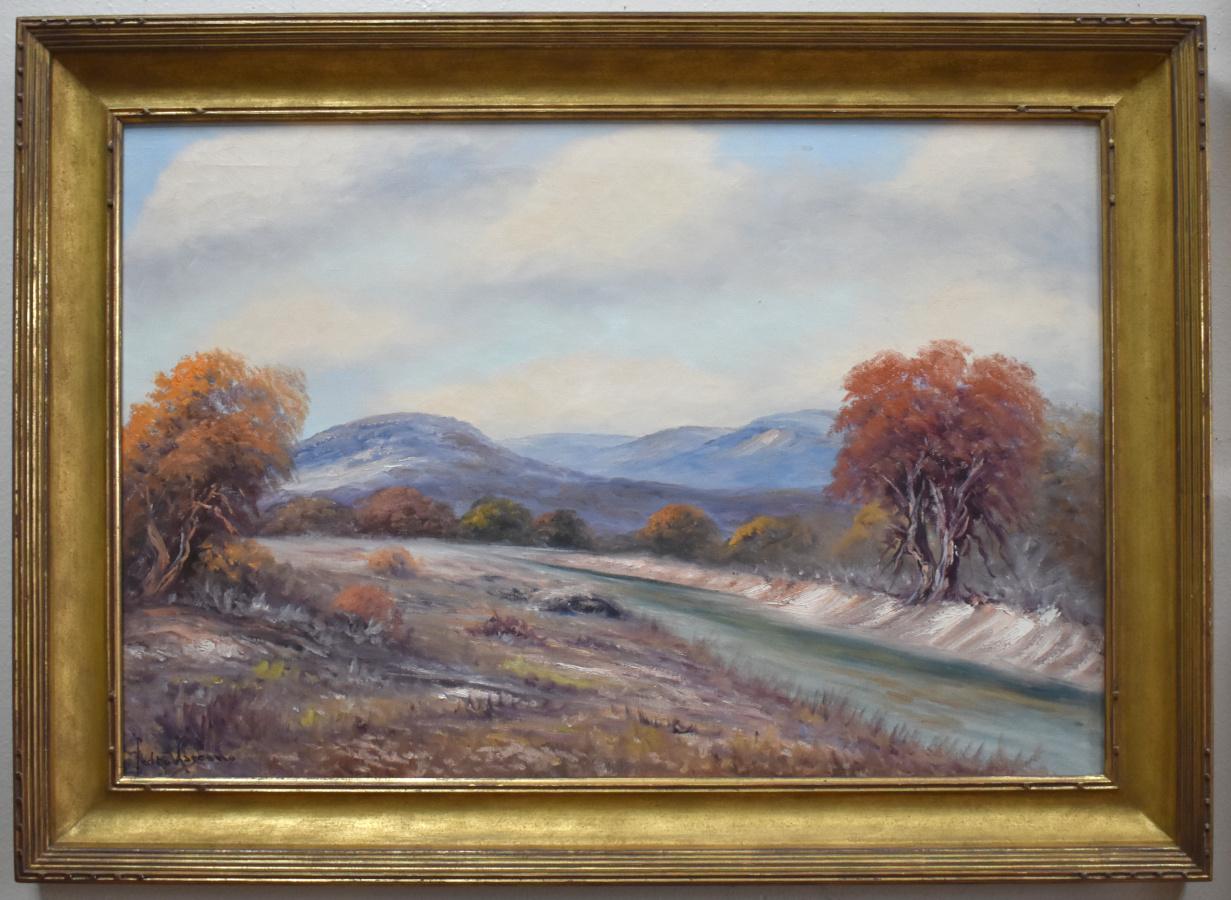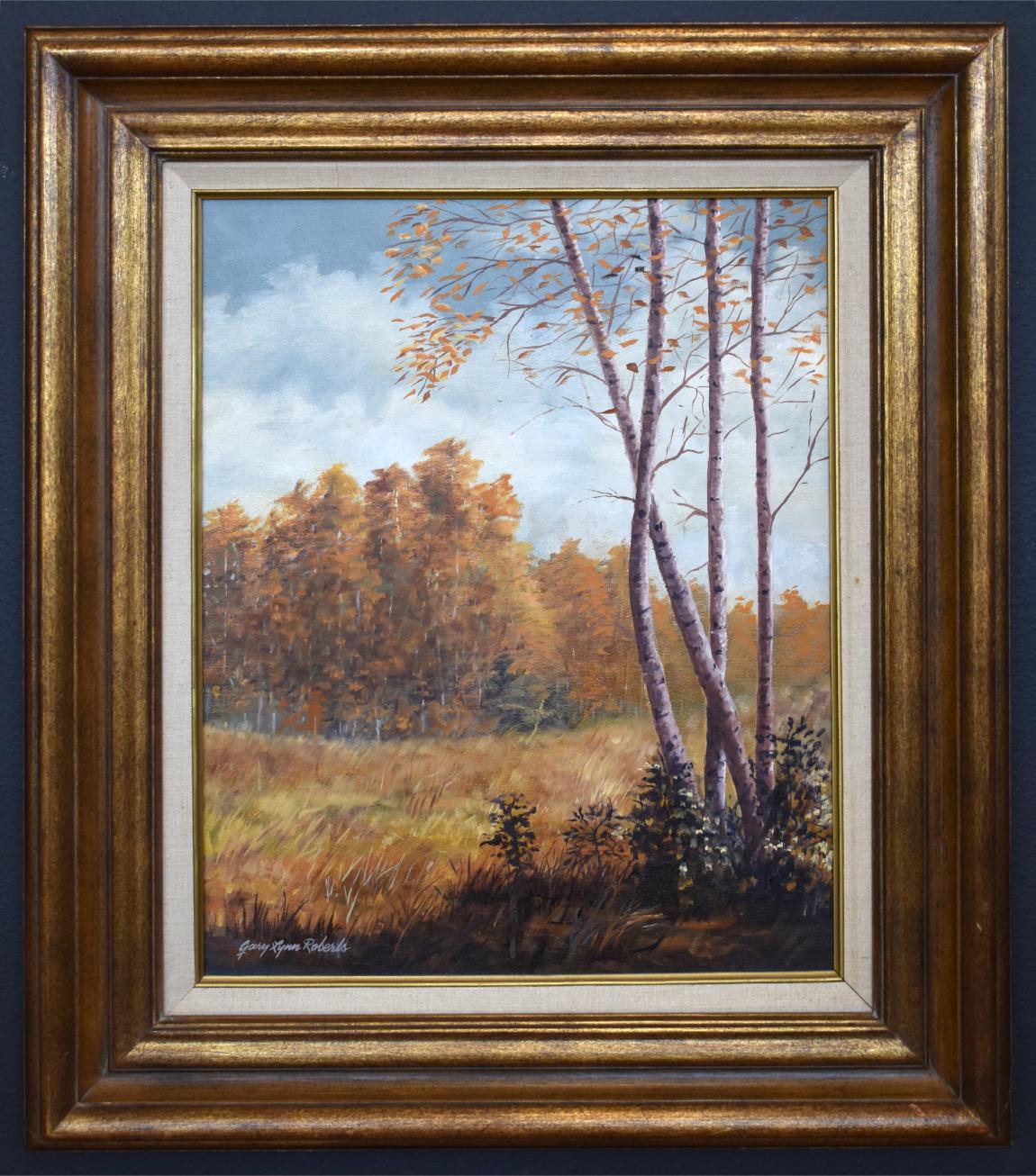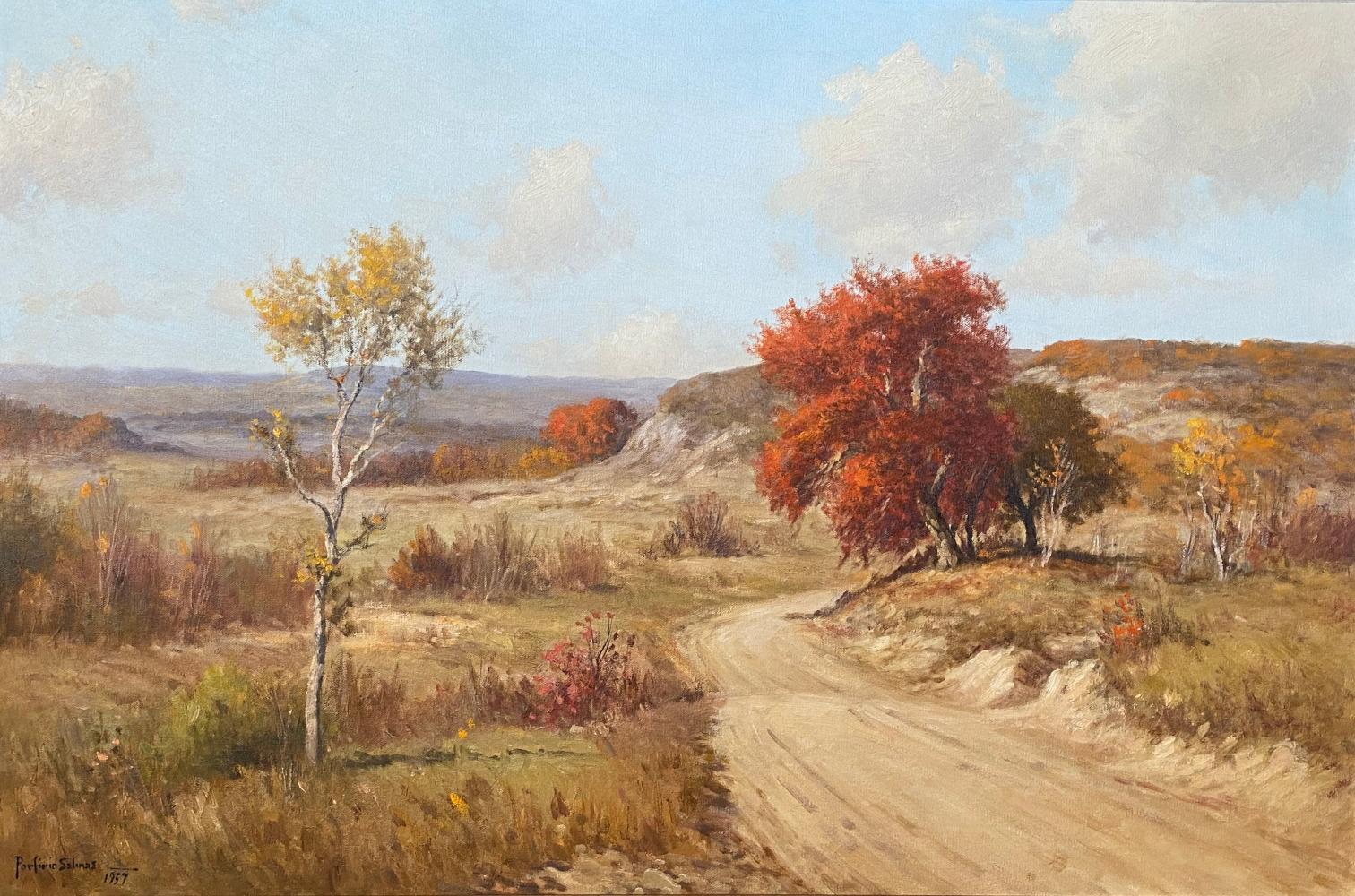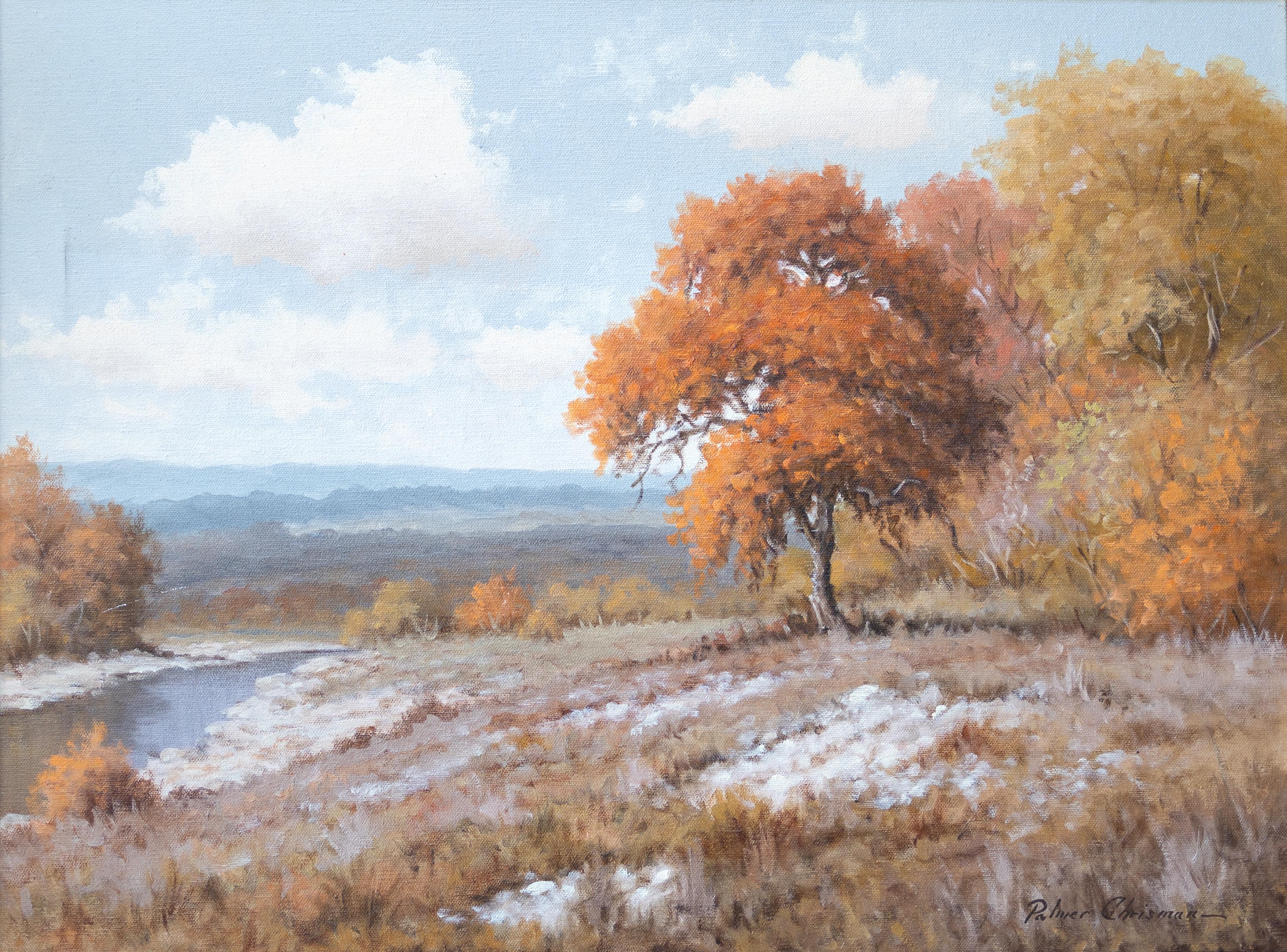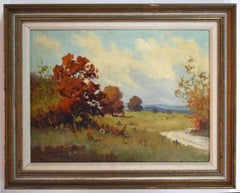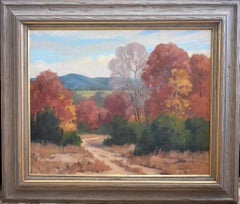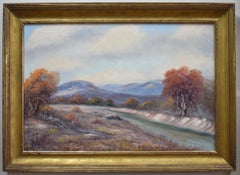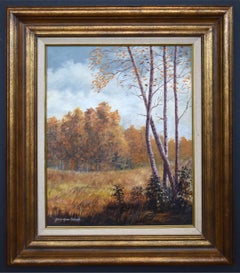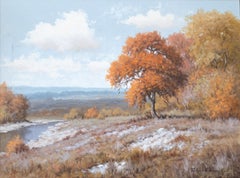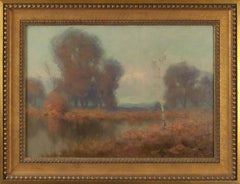Articles similaires à « Texas AUTUMN » TEXAS HILL COUNTRY ROBERT WOOD
Vous voulez plus d'images ou de vidéos ?
Demander au vendeur plus d'images ou de vidéos
1 sur 7
Robert W. Wood« Texas AUTUMN » TEXAS HILL COUNTRY ROBERT WOODCirca 1960s
Circa 1960s
14 821,17 €
À propos de cet article
Robert Wood (G. Day)
(1889 -1979)
San Antonio Artist
Image Size: 24 x 36
Frame Size: 34 x 46
Medium: Oil on Canvas
"Texas Autumn"
Biography
Robert Wood (G. Day) (1889 -1979)
A painter of realistic landscapes reflecting a vanishing wilderness in America, Robert Wood (not to be confused with Robert E. Wood) is reportedly one of the most mass-produced artists in the United States. His painting became so popular he was unable to meet all of the demands, and many of his works were reproduced in lithographs and mass distributed as prints, place mats, and wall murals by companies including Sears, Roebuck. He was born in Sandgate, Kent on the south coast of England near Dover, the son of W.L. Wood, a famous home and church painter who recognized and supported his son's talent. In fact, he forced his son to paint by keeping him inside to paint rather than playing with his friends. At age 12, Wood entered the South Kensington School of Art. As a youth, he came to the United States in 1910, having served in the Royal Army, and he never returned to England. He traveled extensively all over the United States, especially in the West, often in freight cars, and also painted in Mexico and Canada. His itinerant existence took him to Illinois where he worked as a farmhand, to Pensacola, Florida where he married, briefly in Ohio, Seattle, Washington, and Portland, Oregon. In 1912, he was in Los Angeles, and In the late 1920s and early 1930s, in San Antonio, Texas, where he lived and in 1928 exhibited in the "Texas Wildflower Competition." From San Antonio, he gained a national reputation for his strong colored, dramatic paintings. Some of that prestige has been credited to his association with Jose Arpa, prominent Texas artist. Wood also gave art lessons, and one of his students was Porfirio Salinas. During this period, Wood sometimes signed his paintings G. Day or Trebor, which is Robert spelled backwards. In 1941 he went to California and painted numerous desert and mountain landscapes and coastal scenes. He lived in Carmel for seven years, and then moved to Woodstock, New York, but he soon returned to California, settling first in Laguna Beach, then San Diego, and finally in the High Sierras, where he and his wife built a home and studio near Bishop and lived until his death in 1979. Robert Wood was born March 4, 1889 in Sandgate, England, a small town on the Kentish coast not far from the white cliffs of Dover. His father, W. J. Wood was a successful painter who recognized Robert's unusual talent. At the age of twelve, his father enrolled Wood in art school in the small town of Folkestone. He then attended the South Kensington School of Art. While attending art school, Wood won four first awards and three second awards, one each year, a record. In 1910 after service in the Royal Army, nineteen-year-old Wood and his friend, Claude Waters, immigrated to America. Initially, he settled in Illinois and worked as a hired hand on a farm belonging to Water's uncle. He would then strike out on his own, living the life of an itinerant painter. Wood traveled as a hobo, hopping freight trains and selling or bartering small paintings to support him along the way. When times were hard, he worked at whatever job was available. In this manner, he saw most of the United States and fell in love with rural America. By 1912, Wood visited Los Angeles for the first time, arriving on the day of the Titanic tragedy. Later that year, he had met, courted and married young Eyssel Del Wagoner in Florida. The couple moved to Ohio where a daughter, Florence, was born. During World War I, the family moved to Seattle where a son, John Robert Wood, was born in 1919. In the early 1920's, the young Wood family was almost constantly on the move. They stayed for short periods in Kansas, Missouri, California and for a longer time in Portland, Oregon, where Wood's friend Claude Waters had settled. Wood's seemingly endless wanderings disrupted his family life and delayed his development as a painter. However, through his travels he developed an appreciation for the American landscape that would inspire him for the rest of his career. Although aware of the current movement away from traditional realism in American art, he elected to travel that solitary path and remain true to his own vision of America's grandeur and beauty poetically translated through his landscape and seascape paintings. In 1923, the Wood family discovered the beautiful city of San Antonio, Texas and it was there that he and his family would finally settle. He studied briefly at the San Antonio Art School with Spanish colorist Jose Arpa y Perea (1860-1952), who had arrived in San Antonio that same year. In the latter part of the 1920’s, Jose Arpa’s influence quickly became evident. Wood after several years of experimentation was becoming a fine easel painter, capable of great subtlety with a new mature original style. Like Texas painters Robert Onderdonk (1853-1917) and his son Julian Onderdonk (1882-1922), Robert Wood concentrated on the distinctive Texas landscape with its Red Oak trees and wildflowers that covered the hill country landscape. He developed a reputation for his scenes of Blue Bluebonnets, the state flower. In the spring, the Texas prairie is covered with wildflowers, especially in the hill country surrounding San Antonio and Austin. Wood incorporated native stone barns and rough wood farm houses that added authenticity and romance to his compositions. In 1925, Wood was divorced from his wife. In 1932, he moved to the famous scenic loop on San Antonio's outskirts. While still living in Texas, he took extensive western sketching trips that brought him to California. It is evident that his 1930’s California and Texas works started to show his awareness of the then popular California Plein-Air movement. These more mature works are distinguished by a fine sense of detail reminiscent of late-19th-century American landscape painters laced with the colorful influence of American and French impressionism. With paintings being shipped to dealers across the continent, Wood’s reputation with collectors was growing nationally. It should be noted that from 1924 and 1940 Robert Wood also signed his paintings G. Day (Good Day) and Trebor (Robert backwards). He only used these signatures during these years (1924- 1940) and there is conflicting information as to why. In 1941 after seventeen years in Texas, Robert Wood and his second wife Tula, who he had met in San Antonio, moved to the coastal town of Laguna Beach, California. Laguna had been an artist colony since early in the century and it was the birthplace for California Plein-Air School, which was still active. While in Laguna, he developed a following for both his landscapes and marine paintings. Wood's paintings of the California coast remained a significant part of his oeuvre. Living in Laguna for seven years, Robert Wood became an active member of the Laguna Art Association and an exhibitor at the annual Laguna Festival of the Arts. After the War in 1948, the Woods moved east and bought a home in Woodstock, New York, which he had visited in the 1930’s. It was a popular artist colony located in the Catskills Mountains. He purchased a studio hidden deep in the Wood Stock forest where Maples and Elms, as well as a quiet brook surrounded his small rustic studio. He found inspiration from the bold autumn colors of the forest, the Catskill Mountains covered in pillows of snow and the blossoming fruit trees of spring. During this period, he made sketching trips to New Hampshire, Vermont and along the Maine coast. Although included in his eastern subjects, these Vermont, New Hampshire and Maine subjects are rare when compared to the hundreds of paintings done while in Woodstock. The public was captivated with Roberts Wood’s seasonal Woodstock paintings. He began working with an inexpensive print publishing house (possibly Donald Art Publishing Co.) to reproduce several of his paintings. The reproductions were an immediate success. October Morn, which was his most successful print, sold more than one million copies in less than two years. These inexpensive paper reproductions made Robert Wood one of America's most famous landscape painters. After a few years in New York, Robert and Tula moved back to Laguna Beach. 1952 and 1953 were tumultuous years for Robert Wood. He and Tula became increasingly estranged and they were divorced in 1952. The following year, Wood was hit by a car on Pacific Coast Highway and nearly died. His friend and amateur artist Caryl Price helped him around the house during his recovery and the two were soon married. He had instructed Caryl in painting and he would take her on sketching trips all throughout the west. During the 1950's, a combination of the popularity of Robert Wood's paintings and his print royalties eventually made him a comfortable living. It was during this period that Grand Tetons became a favorite subject. Although Robert Wood painted extensively in the Colorado Rockies in the 1930s and 1940s, he did not paint the Tetons until the late 1950s. By the early 1960s, the Tetons and the California coast made up a significant percentage of his artistic production. Wood would continue to paint his popular Texas landscapes but his style had changed. Works from this period are more broadly painted with a more chromatic palette, which was considerably different than those from the 1930s and 1940s. In the 1960's, Robert Wood found great success and his paintings brought higher prices, some selling in excess of five thousand dollars. At the age of eighty, the American Express Company commissioned him to paint a series of six works to be reproduced as limited edition serigraphs for their Cardholders. Each print depicted one of the National Parks, subjects that were well known to Wood. Around 1964, Robert and Caryl Wood moved to San Diego. They had purchased a wonderful Victorian house that Caryl wanted to restore. After several years in San Diego, they finally moved back to Bishop and the Sierras. Wood remained active and he continued to paint until just prior to his death in the spring of 1979, just weeks before his 90th birthday. Although Robert Wood shunned publicity and was modest about his accomplishments, he had millions of admirers who mourn his passing. There are thousands of artists in this country who learned a great deal by studying his work, his reproductions and through the art instruction books he authored for Walter Foster publishing.
- Créateur:Robert W. Wood (1889 - 1979, Américain)
- Année de création:Circa 1960s
- Dimensions:Hauteur : 60,96 cm (24 po)Largeur : 91,44 cm (36 po)Profondeur : 7,62 cm (3 po)
- Autres éditions et dimensions:Image Size: 24 x 36 Frame Size: 34 x 46Prix : 14 821 €
- Support:
- Mouvement et style:
- Période:
- Encadrement:Cadre inclusOptions d'encadrement disponibles
- État:Please visit my storefront for more vintage and mid-century artwork.
- Adresse de la galerie:San Antonio, TX
- Numéro de référence:1stDibs : LU769316318462
À propos du vendeur
5,0
Vendeur professionnel agréé
Chaque vendeur répond à des normes strictes en matière d'authenticité et de fiabilité
Établi en 1974
Vendeur 1stDibs depuis 2017
99 ventes sur 1stDibs
Temps de réponse habituel : 1 heure
- ExpéditionRecherche du devis...Expédition depuis : San Antonio, TX
- Politique des retours
Certaines parties de cette page ont été traduites automatiquement. 1stDibs ne garantit pas l'exactitude des traductions. L'anglais est la langue par défaut de ce site web.
Garantie d'authenticité
Bien qu'il soit peu probable que la situation se présente, dans le cas où vous rencontreriez un problème d'authenticité d'un article, contactez-nous dans un délai d'un an pour obtenir un remboursement intégral. DétailsGarantie de remboursement
Si votre article n'est pas conforme à la description, est endommagé pendant le transport ou ne vous est pas livré, contactez-nous sous 7 jours pour obtenir un remboursement intégral. DétailsAnnulation sous 24 heures
Vous disposez d'un délai de 24 heures pour annuler votre achat sans motif.Des vendeurs professionnels agréés
Nos vendeurs de renommée mondiale doivent respecter des normes strictes en matière de service et de qualité, afin de préserver l'intégrité de nos fiches produit.Garantie d'alignement des prix
Si vous constatez qu'un autre vendeur a mis en vente le même article à un prix inférieur sur un autre site, nous nous alignerons sur ce prix.Livraison en toute confiance à l'international
Notre réseau de transporteurs de premier ordre propose des options d'expédition spécialisées dans le monde entier, y compris des livraisons personnalisées.Plus d'articles de ce vendeur
Tout afficher« AUTUMN PATH » TEXAS HILL COUNTRY - SIGNATURE RARE DE G. DAY
Par Robert W. Wood
Robert Wood (G. Day)
(1889 -1979)
Artiste de San Antonio
Taille : 12 x 16
Cadre : 16 x 20
Médium : Huile
"Chemin d'automne"
Biographie
Robert Wood (G. Day) (1889 -1979)
Peintre de pa...
Catégorie
20ième siècle, Impressionnisme, Peintures - Paysage
Matériaux
Huile
« Texas Hill Country Fall » (automne du Texas) orange, jaune, etc. Fall Colos
Par Harold Roney
Harold Roney Couleurs d'automne. Oranges, jaunes, rouges, etc.
(1899 - 1986)
San Antonio, Boerne Artiste
Taille de l'image : 26 x 32
Taille du cadre : 34 x 40
Médium : Huile
Texas ...
Catégorie
années 1950, Impressionnisme, Peintures - Paysage
« Hill COUNTRY CREEK » TEXAS AUTUMN FRAMÉ 30,5 X 42,5
Par Pedro Lazcano
Pedro Lazcano
(1909-1970)
Artiste de San Antonio
Taille de l'image : 24 x 36
Taille du cadre : 30,5 x 42,5
Médium : Huile
"Ruisseau du pays des collines"
Pedro Lazcano (1909-1970)
J'...
Catégorie
années 1960, Impressionnisme, Peintures - Paysage
Matériaux
Huile
"PAYSAGE D'AUTOMNE" PAYS DES COLLINES
Par Gary Lynn Roberts
Gary Lynn Roberts
(Né en 1953)
Artiste du Texas
Taille de l'image : 20 x 16
Taille du cadre : 28,5 x 24,5
Médium : Huile
Daté de 1973
"Paysage d'automne
Gary Lynn Roberts (Né en 1953...
Catégorie
années 1970, Impressionnisme, Peintures - Paysage
Matériaux
Huile
«ILL COUNTRY RANCH ROAD » (Route de chasse du quartier) TEXAS HILL COUNTRY AUTUMN - Grande taille FRAMÉE 37 X 49
Par Porfirio Salinas
Porfirio Salinas
(1910-1973)
Artiste de San Antonio
Taille de l'image : 24 x 36
Taille du cadre : 37 x 49
Médium : Huile
Daté de 1957
"Route du ranch de Hill Country"
Porfirio Salina...
Catégorie
années 1950, Impressionnisme, Peintures - Paysage
Matériaux
Huile
« Texas SUMMER » HILL COUNTRY CIRCA 1930'S 1872-1957 COMFORT ARTIST
P. I.L.A. (Peter Lanz)
(1872 - 1957)
San Antonio, Comfort Artistics
Taille de l'image : 12 x 16
Médium : Huile
Circa 1930s
"Été texan" Pays des collines
Biographie
P. L. Hohnstedt (P...
Catégorie
années 1930, Impressionnisme, Peintures - Paysage
Matériaux
Huile
Suggestions
Paysage d'automne de la région des collines du Texas
Cette scène de paysage automnal chaleureux de Palmer Chrisman (1913-1984) représente une vue à flanc de colline d'un arbre aux feuilles orangées et d'un ruisseau avec des collines bl...
Catégorie
20ième siècle, Naturalisme, Peintures - Paysage
Matériaux
Toile, Huile
Paysage californien à l'automne
Cette œuvre d'art "California Landscape in Autumn" c.1980, est une peinture à l'huile sur toile de l'artiste californien Bill Shaddix, né en 1930. Il est signé dans le coin inférieur...
Catégorie
Fin du 20e siècle, Impressionnisme américain, Peintures - Paysage
Matériaux
Huile
Paysage idéaliste d'automne du Texas
Par Dollie Nabinger
Paysage aux couleurs pastel du Texas en automne. Signé par l'artiste dans le coin inférieur gauche. Encadré dans un élégant cadre doré.
Biographie de l'artiste : L'artiste paysagist...
Catégorie
années 1950, Réalisme, Peintures - Paysage
Matériaux
Huile
Paysage d'automne
Par Royal Milleson
Paysage d'automne
Huile sur toile reliftée, c. 1915
Signé dans le coin inférieur droit : "Royal H. Milleson"
Condit : Excellent
Taille de la toile : 14 1/2 x 20 3/8 pouces
Taille du ...
Catégorie
Années 1910, Impressionnisme américain, Peintures - Paysage
Matériaux
Huile
Peinture de paysage d'automne signée par W.E. Beatty
W.E. Beatty
Sans titre (paysage d'automne), c. C. C.
Huile sur toile
16 x 20 in.
Encadré : 22 1/2 x 26 1/2 in.
Signé en bas à droite : W E BEATTY
Catégorie
20ième siècle, Impressionnisme américain, Peintures - Paysage
Matériaux
Huile
Peinture impressionniste américaine Woodstock Artistics John F Carlson Autumn Splendor (Splendeur de l'automne)
Splendeur de l'automne
huile sur toile
Taille de l'image 10 x 8, 16 x 14 encadré
Le tableau est en excellent état dans un cadre impressionniste doré montrant la maîtrise de la lumièr...
Catégorie
XXIe siècle et contemporain, Impressionnisme, Peintures - Paysage
Matériaux
Huile
5 999 € Prix de vente
20 % de remise
